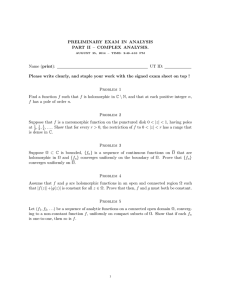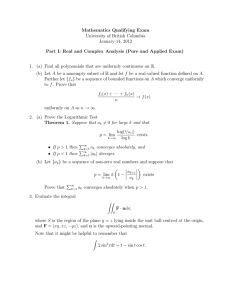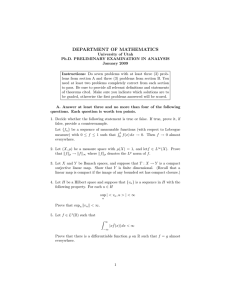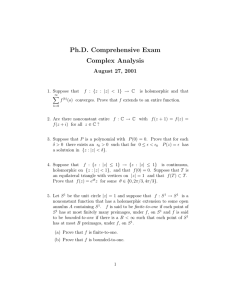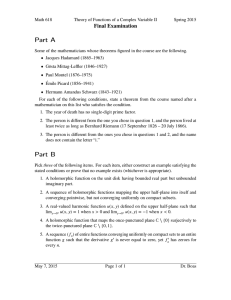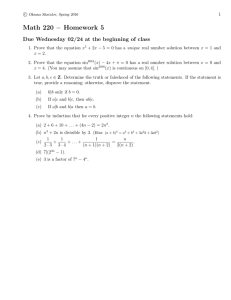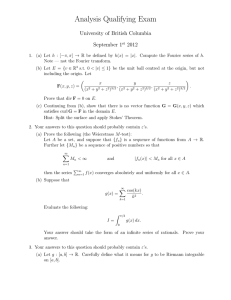Mathematics Qualifying Exam University of British Columbia January 14, 2012
advertisement
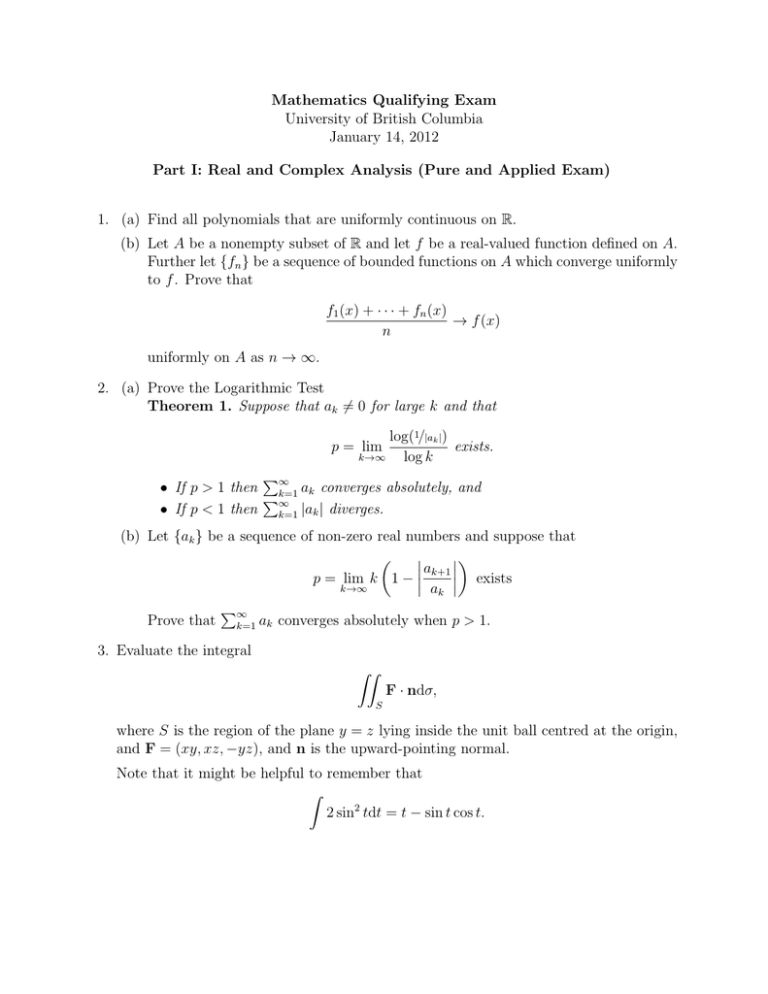
Mathematics Qualifying Exam
University of British Columbia
January 14, 2012
Part I: Real and Complex Analysis (Pure and Applied Exam)
1. (a) Find all polynomials that are uniformly continuous on R.
(b) Let A be a nonempty subset of R and let f be a real-valued function defined on A.
Further let {fn } be a sequence of bounded functions on A which converge uniformly
to f . Prove that
f1 (x) + · · · + fn (x)
→ f (x)
n
uniformly on A as n → ∞.
2. (a) Prove the Logarithmic Test
Theorem 1. Suppose that ak #= 0 for large k and that
log(1/|ak |)
exists.
k→∞
log k
p = lim
!
• If p > 1 then ∞
k=1 ak converges absolutely, and
!∞
• If p < 1 then k=1 |ak | diverges.
(b) Let {ak } be a sequence of non-zero real numbers and suppose that
#
#$
"
# ak+1 #
# exists
p = lim k 1 − ##
k→∞
ak #
!
Prove that ∞
k=1 ak converges absolutely when p > 1.
3. Evaluate the integral
%%
S
F · ndσ,
where S is the region of the plane y = z lying inside the unit ball centred at the origin,
and F = (xy, xz, −yz), and n is the upward-pointing normal.
Note that it might be helpful to remember that
%
2 sin2 tdt = t − sin t cos t.
4. In the following, justify your answer.
(a) (6 points) Prove or disprove:
There exists a holomorphic function f on C (thus an entire function) such that
f (D) = Q where D is the unit disk D = {z ∈ C | |z| < 1} and Q is the square
Q = {z ∈ C | − 1 < Re z, Im z < 1}.
(b) (7 points) Find all holomorphic functions f (z) on C \ {0} such that
f (1) = 1,
|f (z)| ≤
1
|z|3
(c) (7 points) Find a holomorphic function f (z) on D = {z ∈ C | |z| < 1}, which maps
D onto the infinite sector
S = {z = reiθ ∈ C | 0 < θ < π/4}.
5. (a) (6 points) Prove or disprove:
There exists a nonconstant holomorphic function f (z) from D = {z ∈ C | |z| < 1}
into C such that the area of its image, area f (D) = 0.
(b) (7 points) Show that there is no holomorphic function f (z) on D = {z ∈ C | |z| < 1}
such that |f (z)| = |z|1/2 for all z ∈ D.
(c) (7 points) Find all harmonic functions u(x, y) on R2 such that eu(x,y) ≤ 10+(x2 +y 2 )
and u(1, 1) = 0.
6. (20 points) Evaluate the following integral, using contour integration, carefully justifying
each step:
% ∞
log x
dx
(1 + x2 )2
0
Page 2
Mathematics Qualifying Exam
University of British Columbia
January 14, 2012
Part II: Linear Algebra and Algebra (pure exam)
1. Determine the eigenvalues and a basis of the corresponding eigenspaces for the linear
map f : R3 → R3 given by the matrix A with respect to the standard basis, where:
5 4 2
A = 4 5 2 .
2 2 2
Note: all eigenvalues are rational numbers.
2. Let Nn ⊂ Mn (R) be the set of nilpotent matrices, that is the set of n × n matrices A
such that Ak = 0 for some k. Show that Nn is a closed subset of Mn (R) (identify the
2
latter with Rn ).
3. Let T : Rn → Rm be a linear map.
(a) Show that there is a unique integer 0 ≤ k ≤ min {n, m} for which there are bases
m
{ui }ni=1 ⊂ Rn {v i }m
such that the matrix of T with respect to these bases
i=1 ⊂ R
(k)
is D , where
%
1 1≤i=j≤k
D(k) =
,
0 otherewise
that is D(k) has zeroes everywhere except that the first k entries on the main
diagonal are 1.
(b) Show that the row rank and column rank of any matrix A ∈ Mm,n (R) are equal.
4. (a) Suppose that the order of a finite group G is divisible by 3 but not 9. Show that
there are either one or two conjugacy classes of elements of order 3 in G.
(b) Give examples of finite groups A, B, C of order divisible by 3 so that the orders of
A, B are not divisible by 9 and they have one and two conjugacy classes of elements
of order 3, respectively, and so that the order of C is divisible by 9 and it has more
than two such conjugacy classes.
1
r
5. (a) Let R be an integral domain, and let f ∈ R[x] be a polynomial.
!r Let {ai }i=1 ⊂ R
be distinct, and suppose that f (ai ) = 0 for all i. Show that i=1 (x − ai ) divides f
in R[x].
(b) Let {ai }ni=1 , {bj }nj=1 be algebraically indepedent, and let F = Q(a, b) be the field
of rational functions in 2n variables over Q. Let A ∈ Mn (F ) be the matrix where
1
Aij = ai −b
. Show that
j
det A = cn
for some universal cn ∈ Q.
!
1≤i<j≤n ((ai − aj )(bi − bj ))
!n !n
i=1
j=1 (ai − bj )
For n = 2 this identity is:
#
" 1
1
a1 −b2
1
=−
det a1 −b
1
1
a2 −b1
a2 −b2
(a1 − a2 )(b1 − b2 )
.
(a1 − b1 )(a1 − b2 )(a2 − b1 )(a2 − b2 )
6. Let f (x) = x6 + 5x3 + 1 ∈ Q[x].
(a) Construct a splitting field Σ for f by adjoining at most √
two elements to Q. You
−1+ −3
may wish to use the primitive cube root of unity ω =
.
2
√
√
(b) Given that f has no root in Q( −3, 21) find [Σ : Q] and show that f is irreducible
in Q[x].
(c) Let β ∈ Σ be a root of F . Show that there exist unique ρ, σ ∈ Gal(Σ : Q) so that:
ρ(β) = β1 , ρ(ω) = ω, σ(β) = β, σ(ω) = ω 2 . Also, show that ρ and σ commute.
Page 2
